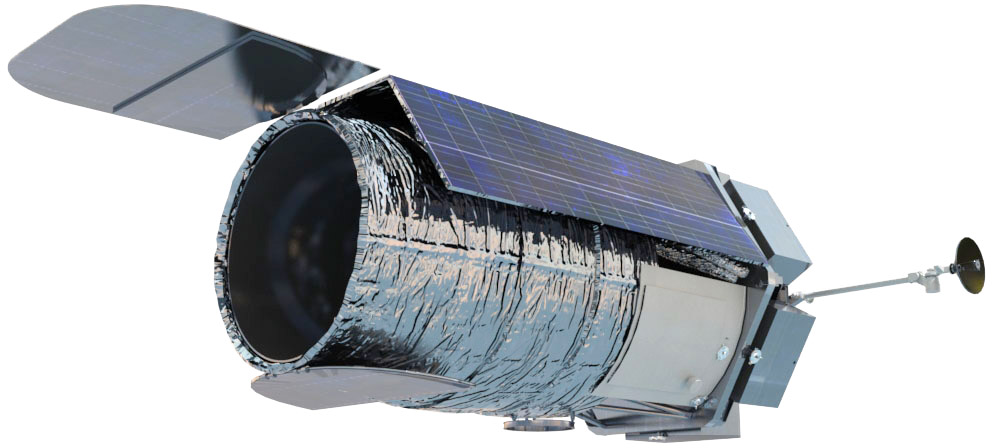NASA Mulls Spy Agency's Telescopes for Dark-Energy Mission

NASA is considering requesting money in next year's budget to eventually start using two space telescopes it received from the United States' spy satellite agency, a senior official told Space.com.
NASA received the telescopes from the National Reconnaissance Office (NRO) in 2012. They have the same resolution as the agency's famous Hubble Space Telescope, but a field of view 200 times wider.
The telescopes are being eyed for use in a potential space mission called WFIRST-AFTA (the Wide Field Infrared Survey Telescope-Astrophysics Focused Telescope Assets), which could launch as early as 2024 if it gets the final go-ahead. WFIRST-AFTA's science goals include learning more about the mysterious dark energy that is accelerating the expansion of the universe. [8 Baffling Astronomy Mysteries]
"We have a goal of using these telescopes as is, and we do not have to make modifications, but we do have to resurface the mirror, as it's been sitting in storage," Paul Hertz, NASA's astrophysics chief, told Space.com. "But we are going to use them as is and design the spacecraft and the instruments to take advantage of their properties."
Science case
In mid-March, Hertz received a report from WFIRST-AFTA's science-definition team that presented an overview of the proposed design and activities for the mission.
Should the program move forward, one of the telescopes would be used for space observations, while the other would remain on the ground as an engineering test bed. At some point, the engineering telescope could be freed for other uses — including, perhaps, a space mission, Hertz said.
A wide-field infrared telescope was identified as a priority in the U.S. National Research Council's 2010 decadal survey for astronomy. However, the telescope must pass several hurdles before getting into space.
Get the Space.com Newsletter
Breaking space news, the latest updates on rocket launches, skywatching events and more!
If NASA's astrophysics division approves the mission, the agency will formulate a budgetary and programmatic request to send to the White House for the 2017 budget. That budget is subject to approval by Congress. Should the telescope be funded, the contractors for WFIRST-AFTA will be selected roughly four years before launch.
Hertz said the cost of WFIRST-AFTA is not yet known, although he said it would be a large mission. He added that NASA wants to be sure of budgetary numbers before releasing figures; while he didn't mention it, the space agency has come under fire for cost overruns on Hubble and the James Webb Space Telescope, among other programs.
"We don't want to be surprised, and we don't want to underestimate that cost and give people a false impression," Hertz said.
Better than expected
The NRO's telescopes were originally intended for a multi-billion-dollar program called Future Imagery Architecture, but the program was cancelled in 2005 following delays and budget overruns. The telescopes are in storage in a contractor's facility, where they will remain until NASA decides what to do with them.
David Spergel, who is co-chair for WFIRST-AFTA's science-definition team, told Space.com that the 2012 announcement that NASA had been given the telescopes came as a surprise. To scientists' delight, the 8-foot-wide (2.4 meters) telescopes are even better than the 5.2-foot (1.6 m) instrument called for by WFIRST's initial designs.
"With a more powerful telescope, you do more science," Spergel said. The mission would also search for exoplanets, among other goals.
Instrument development is ongoing at NASA centers, including improving detector technologies and developing a coronagraph (a device to block out the light of stars so the telescopes can better see exoplanets).
The science-definition team is now mulling whether it's better to place the telescope relatively close to Earth, to a spot from which it could send data home quickly, or farther away, so that Earth would not block the instrument's view. WFIRST-AFTA would either be placed in geosynchronous orbit a few thousand miles from Earth, or at a stable gravitational point called Earth-sun L2, which is about 930,000 miles (1.5 million km) from the planet.
Follow Elizabeth Howell @howellspace, or Space.com @Spacedotcom. We're also on Facebook and Google+. Originally published on Space.com.
Join our Space Forums to keep talking space on the latest missions, night sky and more! And if you have a news tip, correction or comment, let us know at: community@space.com.

Elizabeth Howell (she/her), Ph.D., was a staff writer in the spaceflight channel between 2022 and 2024 specializing in Canadian space news. She was contributing writer for Space.com for 10 years from 2012 to 2024. Elizabeth's reporting includes multiple exclusives with the White House, leading world coverage about a lost-and-found space tomato on the International Space Station, witnessing five human spaceflight launches on two continents, flying parabolic, working inside a spacesuit, and participating in a simulated Mars mission. Her latest book, "Why Am I Taller?" (ECW Press, 2022) is co-written with astronaut Dave Williams.









